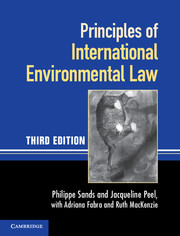Book contents
- Frontmatter
- Contents
- Foreword
- Preface and acknowledgments to the first edition
- Preface and acknowledgments to the second edition
- Preface and acknowledgments to the third edition
- Table of cases
- Table of treaties and other international instruments
- Abbreviations
- Part I The legal and institutional framework
- 1 The environment and international society: issues, concepts and definitions
- 2 History
- 3 Governance: states, international organisations and non-state actors
- 4 International law-making and regulation
- 5 Compliance: implementation, enforcement, dispute settlement
- Part II Principles and rules establishing standards
- Part III Techniques for implementing international principles and rules
- Part IV Linkage of international environmental law and other areas of international law
- Index
- References
2 - History
from Part I - The legal and institutional framework
Published online by Cambridge University Press: 05 June 2012
- Frontmatter
- Contents
- Foreword
- Preface and acknowledgments to the first edition
- Preface and acknowledgments to the second edition
- Preface and acknowledgments to the third edition
- Table of cases
- Table of treaties and other international instruments
- Abbreviations
- Part I The legal and institutional framework
- 1 The environment and international society: issues, concepts and definitions
- 2 History
- 3 Governance: states, international organisations and non-state actors
- 4 International law-making and regulation
- 5 Compliance: implementation, enforcement, dispute settlement
- Part II Principles and rules establishing standards
- Part III Techniques for implementing international principles and rules
- Part IV Linkage of international environmental law and other areas of international law
- Index
- References
Summary
INTRODUCTION
Modern international environmental law can be traced directly to international legal developments that took place in the second half of the nineteenth century. Thus, although the current form and structure of the subject emerged in the mid-1980s, a proper understanding of modern principles and rules requires a historic sense of earlier scientific, political and legal developments. International environmental law has evolved over four distinct periods, reflecting developments in scientific knowledge, the application of new technologies and an understanding of their impacts, changes in political consciousness and the changing structure of the international legal order and institutions.
A first period began with bilateral fisheries treaties in the nineteenth century, and concluded with the creation of the new international organisations in 1945. During this period, peoples and nations began to understand that the process of industrialisation and development required limitations on the exploitation of certain natural resources (flora and fauna) and the adoption of appropriate legal instruments. The second period commenced with the creation of the UN and culminated with the UN Conference on the Human Environment, held in Stockholm in June 1972. Over this period, a range of international organisations with competence in environmental matters was created, and legal instruments were adopted, at both the regional and the global levels, which addressed particular sources of pollution and the conservation of general and particular environmental resources, such as oil pollution, nuclear testing, wetlands, the marine environment and its living resources, the quality of freshwaters and the dumping of waste at sea. The third period ran from the 1972 Stockholm Conference and concluded with the UN Conference on Environment and Development (UNCED) in June 1992. During this period, the UN tried to put in place a system for co-ordinating responses to international environmental issues, regional and global conventions were adopted, and for the first time the production, consumption and international trade in certain products were banned at the global level. The fourth period was set in motion by UNCED, and may be characterised as a period of integration: when environmental concerns should, as a matter of international law and policy, be integrated into all activities. This has also been the period in which increased attention has been paid to compliance with international environmental obligations, with the result that there is now a well-developed body of international jurisprudence.
- Type
- Chapter
- Information
- Principles of International Environmental Law , pp. 22 - 49Publisher: Cambridge University PressPrint publication year: 2012



